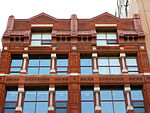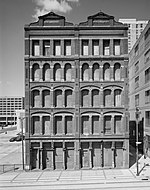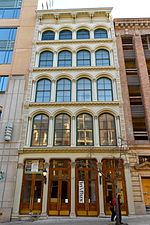Emerson Bromo-Seltzer Tower

The Emerson Tower (often called the Bromo-Seltzer Tower or the Bromo Tower) is a 15-story, 88 m (289 ft) clock tower erected in 1907–1911 at 21 South Eutaw Street, at the northeast corner of Eutaw and West Lombard Streets in downtown Baltimore, Maryland. It was the tallest building in the city from 1911 to 1923, until supplanted by the Citizens National Bank building (later First National Bank of Maryland, then occupied by MECU - Municipal Employees Credit Union) at the southeast corner of Light and Redwood (German) Streets. It was designed by local architect Joseph Evans Sperry (1854-1930) for Isaac Edward Emerson (1859-1931), who invented the Bromo-Seltzer headache remedy. For years, the landmark tower was surrounded by and part of the Emerson Drug Company with its office headquarters and manufacturing plant for the carbonated headache pain relief tablets or powder Bromo-Seltzer. Later, the Emerson building around it was razed and replaced by the Baltimore City Fire Department's John Steadman Fire Station, which serves the west side of downtown Baltimore. The Steadman Station combined several earlier engine and truck companies in firehouses on the west side. Built in the Brutalist architecture style of poured concrete, the station has lines echoing the surviving tower to its south and west.
Excerpt from the Wikipedia article Emerson Bromo-Seltzer Tower (License: CC BY-SA 3.0, Authors, Images).Emerson Bromo-Seltzer Tower
South Eutaw Street, Baltimore Downtown
Geographical coordinates (GPS) Address Phone number Website External links Nearby Places Show on map
Geographical coordinates (GPS)
| Latitude | Longitude |
|---|---|
| N 39.287694444444 ° | E -76.620638888889 ° |
Address
Bromo Seltzer Arts Tower
South Eutaw Street 21
21201 Baltimore, Downtown
Maryland, United States
Open on Google Maps








